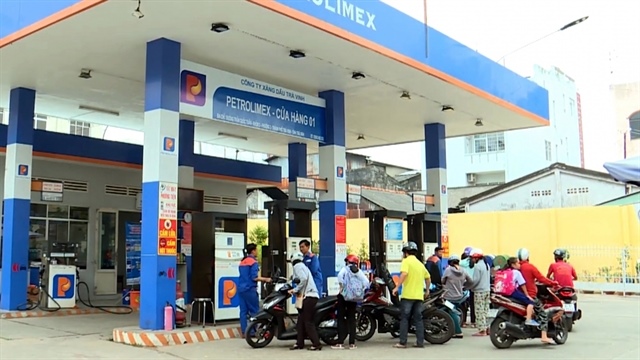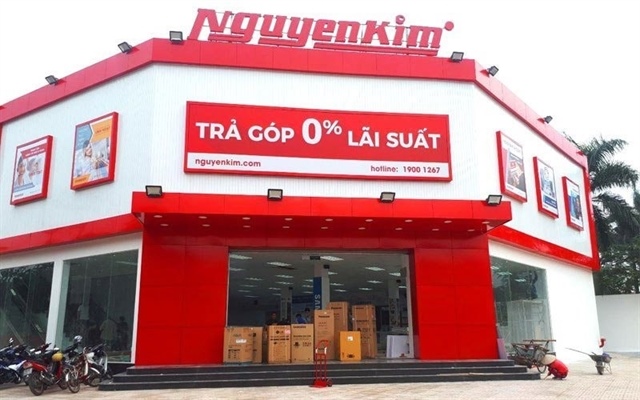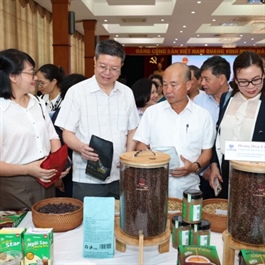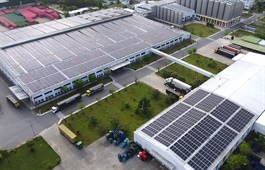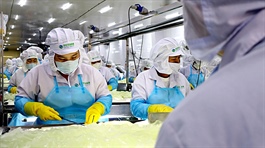Chinese goods inundate Vietnamese market ahead of Tet
Chinese goods inundate Vietnamese market ahead of Tet
A wide range of Chinese-made goods, including religious offerings, lanterns, artificial flowers, scented candles, decor, clothing, beauty products, and snacks, are flooding the Vietnamese market ahead of the Lunar New Year holiday, or Tet.

Chinese-made house decorations for Tet are sold in Ho Chi Minh City. Photo: Thanh Hiep / Tuoi Tre |
The shopping demand surges at the end of the year and Chinese imports have filled traditional markets and retail outlets thanks to low costs and diversified varieties.
Since October, Nguyen Thu Hue, who trades in decorations and religious items at Tan Dinh Market in District 1, Ho Chi Minh City, has sourced more Chinese products to prepare for Tet, due late next month.
She started importing more products when she realized consumers prefer low-cost products when visiting traditional markets, and will not come to such markets to buy high-quality items.
Her profit margins were small when selling locally-made products versus a higher margin from Chinese products.
Trendy trays of Tet treats bought from China have various shapes and patterns, each costing VND200,000-250,000 (US$7.8-9.8), whereas tea sets cost VND180,000 ($7.1) apiece.
A branch of lifelike artificial flowers, complete with a faint fragrance, costs VND10,000 ($0.4).
When these products are sourced locally, they have higher prices.
Hue added that profit from local products was only 7-10 percent of the product prices, versus the 40-80 percent from Chinese imports.
Similarly, religious items, lanterns, and scented candles imported from China are each priced under VND100,000 ($3.9).
Many buyers asked for the origin of the products and accepted Chinese ones without bargains, Hue informed.
The sale of Chinese products before Tet has helped Hue offset her sluggish business in 2024.
The number of traders of Chinese goods is huge, with some vendors who used to offer domestic products now abandoning them to switch to Chinese alternatives.
N.T.L., the owner of a clothing shop in District 5, Ho Chi Minh City, shared that she had to borrow money to purchase goods for Tet in previous years.
However, she faced no monetary pressure this year as she shifted to importing Chinese goods that require smaller capital.
She noted that she sells items in her shops and also distributes them to traders in other provinces, adding that she can earn more profits from Chinese products.
The period before Tet also tends to witness a surge in demand for technological products.
Nguyen Tri Thien in District 5 said he has begun trading Chinese Bluetooth headsets, speakers, smart watches, and phone cases.
Bluetooth headsets fetch VND10,000 ($0.4) to VND200,000 ($7.8) each.
Thien pockets 20 percent per product, while the rate is only five percent for Vietnamese products.
He stated that he usually purchases Chinese products via partners at Kim Bien Market in District 5 and Binh Tay Market in District 6.
He only spends VND5 million ($196) buying products that he sells on e-commerce platforms.
Chinese snacks, such as mochi, salted egg cookies, chocolate cakes, and sponge cakes topped with pork floss, are popular with young Vietnamese.
Many shop owners claimed that cosmetics sales have improved.
They can earn a profit of up to 50 percent from Chinese face masks sold between VND10,000 ($0.4) and VND14,000 ($0.5).
Meanwhile, Vietnamese-made face masks cost some VND35,000 ($1.4) each, and traders only earn VND2,000-3,000 ($0.08-0.1).
Legal compliance is top priority
Nguyen Thanh Nam, an employee responsible for Chinese goods at an import-export company in Tan Binh District, advised local traders to choose commodities carefully.
He warned that without high-quality and well-priced product sources, profit may not be as high as expected.
According to a leader of a Vietnamese consumer goods producer, the trend of importing Chinese products ahead of Tet this year has been strong due to challenges faced by domestic companies and their failure to launch effective promotional campaigns.
He also pointed to the rise of e-commerce platforms which have made it easier to import Chinese goods.
He emphasized that Vietnamese enterprises must embrace competition and suggested that the government create a fair market environment while taking steps to prevent the sale of products of unclear origin or with fraudulent claims.
A leader of the Ho Chi Minh City Department of Industry and Trade stated that Vietnamese traders source Chinese goods from local wholesale markets, agents, and e-commerce platforms, and insisted on their verifying the origin of these products.
He added that product packaging must include all necessary information as required by Vietnamese law.
At the end of this year, the Ho Chi Minh City Market Surveillance Agency seized a large quantity of smuggled goods, including clothing worth over VND920 million ($36,045) and more than 4.3 metric tons of fabric valued at VND652 million ($25,545), which were found in an apartment on Ngo Duc Ke Street in District 1.
Earlier in the year, local authorities also confiscated thousands of smuggled items, including cosmetics, food, electronics, and household appliances, suspected to have been brought in across the northern border.
These commodities had a total value of over VND2.8 billion ($109,921).


